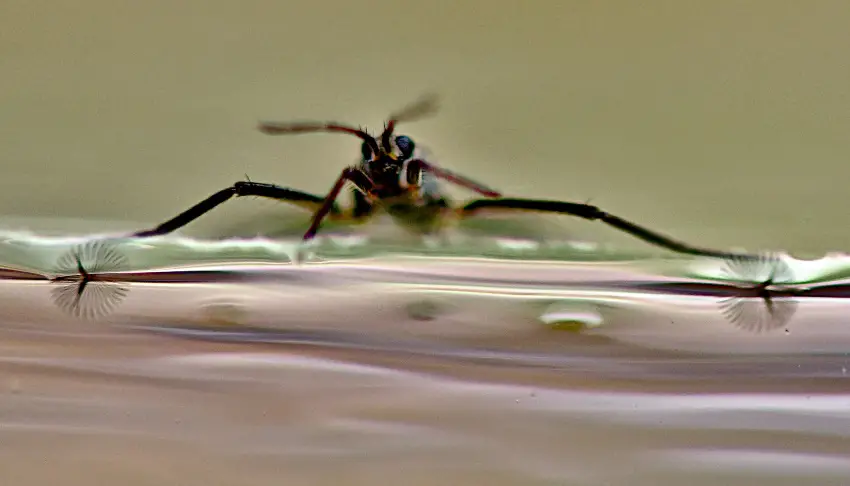In the ever evolving field of robotics, nature continues to serve as the greatest engineer and teacher. Recently, researchers have drawn inspiration from a tiny insect known as Rhagovelia, often called ripple bugs.
This semiaquatic creature, no larger than a grain of rice, has revealed secrets that could revolutionize robotics, particularly in designing machines capable of skating effortlessly on water. The Hermes of the bug world is now inspiring cutting edge innovations in aquatic robotics.
Rhagovelia insects thrive in turbulent waters where many other small creatures would be swept away. Their feather like legs, equipped with fan shaped structures, act almost like miniature wings.
According to Dr. Victor Ortega Jimenez, an integrative biologist at the University of California, Berkeley, these bugs appear as though they have tiny Hermes wings attached to their feet.
Unlike typical water striders that glide on calm ponds, Rhagovelia insects excel in wavy and fast flowing streams. Their unique adaptation enables them to harness water’s surface tension, using it as an ally rather than fighting against it.
Instead of expending significant muscle energy, their fan like feet spread automatically when in contact with water, creating thrust. Once lifted, the fans collapse, reducing drag. This passive yet efficient mechanism is an engineering marvel.
From Biology to Robotics Translating Nature’s Genius
The study published in Science highlights how the mechanics of Rhagovelia can be translated into robotic systems. Engineers have already begun designing small robots that mimic these insects’ leg structures.
By replicating the automatic fan and collapse system, robots can now traverse water surfaces with minimal energy consumption. This breakthrough is not only a tribute to nature’s design but also a step toward sustainable robotics.
Imagine small rescue robots skating across rivers to deliver supplies during floods, or environmental monitoring bots patrolling turbulent streams without requiring large batteries.
Dr. Ortega Jimenez explains, This is an example of how evolution crafts elegant solutions. By studying Rhagovelia, we learn how passive structures can generate motion without costly energy input. This has massive implications for robotics.
Similarly, Dr. Emily Tran, a robotics engineer at MIT not involved in the study, comments, The Hermes of the bug world provides a perfect case study of biomimicry.
We’ve often relied on active mechanical parts in robotics, but passive adaptations like this show us a more efficient path forward.
Biomimicry in Action
Biomimicry the design of technology inspired by natural systems has already transformed multiple industries. For example. Bullet trains in Japan were redesigned based on a kingfisher’s beak, reducing noise and improving energy efficiency.
Sharkskin inspired swimsuits have enhanced Olympic athletes’ performance. Gecko inspired adhesives are now used in advanced climbing robots. Rhagovelia joins this hall of fame, showing how the smallest insects can inspire the future of water robotics.
By developing robots modeled on ripple bugs, researchers are opening new possibilities in river exploration, pollution tracking, and even extraterrestrial missions on watery moons like Europa.
As someone who has spent afternoons by mountain streams, I recall watching water striders gliding across the surface. But ripple bugs move differently. They seem to dance with the current rather than resist it, skipping over ripples with grace.
When you observe them closely, it becomes clear why they’ve been compared to Hermes the Greek messenger god with winged sandals.
For me, this is a powerful reminder humans often chase innovation in laboratories, yet the solutions are already present in nature’s quiet corners.
Watching Rhagovelia in action feels like glimpsing a living blueprint for future technology. What makes Rhagovelia extraordinary is its use of passive propulsion.
Unlike machines that need continuous fuel or electrical input, ripple bugs rely on water’s own forces surface tension and elasticity. Their fan shaped feet function much like a collapsible umbrella. Open on contact, closed when lifted, they turn turbulence into momentum.
This efficiency could be groundbreaking for robotics. Passive mechanisms require fewer moving parts, leading to longer lasting devices with less maintenance. In disaster zones where recharging is impossible, such efficiency could mean the difference between life and death.
Robots modeled on Rhagovelia could be deployed to monitor water quality in rivers, detect pollutants, or even trace microplastics. Their ability to thrive in turbulence makes them perfect candidates for rough environments where traditional equipment struggles.
During floods or hurricanes, delivering small medical kits or communication devices is critical. A Hermes inspired robot could skate across waters carrying essential supplies, reaching places boats or drones cannot.
NASA has long been exploring ways to study extraterrestrial oceans. Imagine a small Hermes inspired rover skating across methane lakes on Saturn’s moon Titan. With low energy passive propulsion, such missions could last longer and cover more ground.
Engineering Challenges Ahead
Despite its promise, adapting ripple bug mechanics into robots is not without challenges. Materials need to be light yet strong, mimicking the delicate balance of insect legs.
Furthermore, scaling the mechanism for larger robots might reduce efficiency, as surface tension behaves differently with size. Yet, these obstacles are what make innovation exciting.
The story of the Hermes of the bug world is more than just a fascinating scientific discovery it’s a vision of how humanity can work with nature rather than against it.
By learning from ripple bugs, engineers are designing robots that skate, glide, and adapt, just as insects do in streams. Instead of brute force, these robots embody elegance. Instead of consuming massive energy, they conserve it. And instead of resisting the environment, they embrace its forces.
The tale of Rhagovelia proves that the future of robotics doesn’t always lie in more complex machines it often lies in simplicity inspired by nature.
The Hermes of the bug world has shown us that wings don’t always need to fly sometimes, they are found on tiny feet dancing across turbulent waters.
From case studies in biomimicry to expert insights, from personal awe to scientific rigor, one truth emerges if we want to design smarter technologies, we must keep listening to nature’s quiet engineers. Rhagovelia has spoken and robotics will never be the same.

